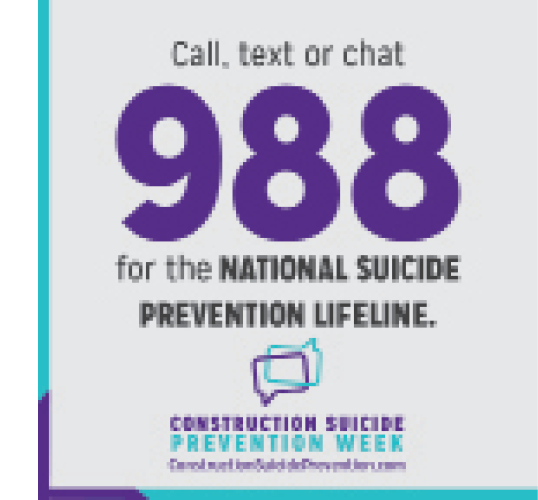
Construction workers often face some of their industry’s most serious dangers—such as falls from elevation, being struck or crushed by equipment or other objects, and electrocution—but recent studies suggest another occupational concern is lurking silently at U.S. worksites: worker suicides. The Centers for Disease Control and Prevention reports that the suicide rate for men in construction and extraction was five times greater than the rate of all other work-related fatalities in the industry in 2018, and these workers are four times more likely to end their own lives than people in the general population.
To assist workers in an industry with one of the nation’s highest occupational suicide rates, the Occupational Safety and Health Administration has joined a task force of construction industry partners, unions and educators to raise awareness of the work stresses seen as the causes of depression and the thoughts and acts of suicide among construction workers. In addition to alerting other stakeholders, the task force encourages industry employers to share and discuss available resources with their workers.
“Construction workers cope with unique causes of stress, such as uncertain seasonal work; remote work and job travel that keeps workers away from home and support systems; long, hard days and completion schedules; and the job-related risks of serious injuries,” explains Assistant Secretary for Occupational Safety and Health Doug Parker. “Left unchecked, these stressors can affect mental health severely and lead to anxiety, depression, substance abuse and, in some cases, suicide.”
The coronavirus outbreak and pandemic only worsened the problem, researchers contend. In August 2020, the CDC reported a considerable one-year increase in symptoms of anxiety or depressive disorder in a survey of the U.S. population. Moved by their concern for a growing problem, a group of industry volunteers joined in 2020 to launch the first Suicide Prevention Week for construction workers. In 2021, more than 68,000 workers in 43 states registered to participate in Construction Suicide Prevention Week, managed by a task force comprised of OSHA, Associated General Contractors, leading construction companies and labor unions.
“Suicide can be prevented with professional help and assistance,” Parker affirms. “OSHA encourages employers, industry associations, labor organizations and workers to use all available resources to understand the problem and warning signs of depression before tragedy strikes.”
The 988 Suicide & Crisis Lifeline is a federally funded project designed to improve crisis services and advance suicide prevention for U.S. residents. Supported by the U.S. Department of Health and Human Services, the 988 Suicide & Crisis Lifeline, formerly the National Suicide Prevention Lifeline, provides free and confidential emotional support to people in suicidal crisis or emotional distress. Available 24 hours a day, 7 days a week, the 998 lifeline is a national network of more than 200 local crisis centers, combining custom local care and resources with national standards and best practices.
INVESTIGATORS CITE MIXER DRUM LOCKOUT/TAGOUT NEAR MISS
A worker performing maintenance inside a mixer at a Mountain State concrete operation narrowly escaped fatal injuries when a co-worker powered up the equipment, according to Occupational Safety and Health Administration investigators. Following a March 2022 incident, the agency issued one willful citation for exposing workers to potential hazards by not developing and using procedures to control hazardous energy and not training employees on the related dangers. Coupled with serious citations, the agency proposed penalties totaled $203,000. Among the citations:
- Not training workers on permit-required confined space hazards and the safety procedures for entering such spaces;
- Failing to train workers on fall hazards and provide fall protection in elevated areas on and around the concrete mixer;
- Failing to periodically inspect their hazardous energy control procedures; and,
- Not training affected employees on the proper procedures for powering on and off devices requiring lockout/tagout devices.
“By sheer good fortune, a worker narrowly avoided much more serious, and potentially, fatal injuries, in an incident that would have never happened if the employer had followed federal requirements to de-energize and lockout the mixer to prevent the machine’s start-up,” says OSHA Area Director Chad Vivian.